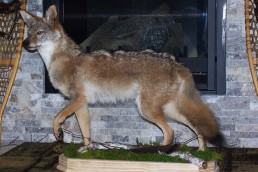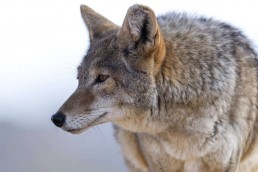Taxidermy Tips for Coyotes
SHARE THIS POST
As my dad and I reached the corner of the field, we separated and then began walking in opposite directions to where we would spend a four-hour vigil on stand. My dad opted to spend his evening hunt in a treestand located in a hemlock tree along an old stump fencerow. My stand of choice was positioned north of a clover food plot in a tall white pine. This was opening day of Michigan’s archery deer season and both of us were thrilled to be back in the woods with bow in hand. The evening was full of promise and we had a front-row seat for the whitetails.
About two hours into the hunt, I heard the familiar sound of my dad’s crossbow in the distance as he released a bolt.
Had he shot a buck?
I had watched him practice with it many times before and knew that whatever it was that set foot in front of him wasn’t going to travel that far. Then, giving the woods some time to settle again, I couldn’t take it any longer. And since my father doesn’t text I had to call him instead. He said around 6 p.m. a coyote came trotting in down the deer trail that was in front of him, 20 yards away. When the ‘yote reached his right shooting lane, he then took the shot. A well-placed bolt caused the coyote to run only 80 yards before tipping over. It was official—the Potters had their first coyote. My parents decided to have a full mount done to capture this memory and display the animal for many years to come.
Whether it’s your first coyote with a bow, shotgun, rifle or crossbow, you might find yourself entertaining the thought of having it mounted by a taxidermist. However, before you pay a visit to the first taxidermy shop you come across, there are important things to consider for a mount to reach its full potential.
Field care
After the shot, there are important steps to take to help “protect” the coyote for the taxidermist. When transporting the animal out of the field, avoid dragging it on the ground or tying a rope around its neck. Instead, use a sled, or if traveling a shorter distance, try to carry it over your shoulder. When you arrive back home you’ll need to wipe any blood, dirt or mud off its fur using either a wet paper towel or rag. If it covers a larger area the hide can be sprayed off using a garden hose or bucket of cold water. If the temperatures are below freezing a coyote can be hung outside by the hind legs so that excess blood can drain and the hide can cool off. When the animal dries, use a fur-grooming comb to remove any burrs or foreign objects from the hide.
Nick Giuliani, owner and taxidermist at NAC Taxidermy, instructed my dad on how to place his coyote in a plastic container packed with ice. This was told to my dad because we were going to take it to the taxidermist the following day. However, if you can’t make it to a taxidermist the day you kill it or the day after, you will then have to place it in a garbage bag and freeze it. If you neglect to do this the hide could slip and fall out of the animal, leaving you disgusted.
Finding a taxidermist
You made a good shot on a coyote and went through great lengths to protect it. Now it’s time to find a reputable taxidermist who will properly preserve it. There are numerous ways to find a skilled professional and see examples of their work before committing to one including online, at booths at various hunting shows, in magazines like MidWest Outdoors and information boards and mount displays at hunting stores. Another way to confirm one’s credibility is to find out if they have won any awards at taxidermy competitions or regularly attend the conventions, which help them improve their craft.
“When choosing a taxidermist, one should always look at his or her work and ask if they compete at state shows,” Giuliani said. “I feel that if a taxidermist competes at shows, they are striving to improve.”
Are you enjoying this post?
You can be among the first to get the latest info on where to go, what to use and how to use it!
Stopping into a taxidermy shop is also a great opportunity to find out pricing information and what types of poses they offer before making a final decision.
“I always welcome people to stop over at my studio to talk and see what we’re working on,” he says.
When my parents and I went to Nick’s shop west of Mt. Pleasant, he went over the different types of poses available for a mount. My parent’s opted for an “alert” pose with the left leg raised as if the coyote was taking its next step. Nick is very patient and strives to make sure that the customer is satisfied with the type of mount they choose.
He pays attention to the details and it shows in his work.
“Quality, is in the materials used, forms that are anatomically correct, hair patterns in the right place and a pelt that’s properly tanned,” Giuliani said.
There are many variables that determine the cost of a full mount of a coyote.
“Prices vary per taxidermist, but you should expect to pay $500 and up, plus the base,” he says. “Prices can go up based on what type of pose you want, and, if alterations will be needed. Base prices will range depending on the type of habitat you want.”
With a never-ending coyote season here in Michigan, be prepared to walk out of the woods with a coyote for a taxidermist. You can be confident knowing that the canine you shot is in good hands. In a few months, you will be able to pick it up and have a quality mount that will capture fond memories of the hunt that will last a lifetime.
Did you enjoy this post?
You can be among the first to get the latest info on where to go, what to use and how to use it!
Darin Potter
Darin Potter’s passion for outdoor writing began at the age of 12 when he first began writing in a journal that his parents bought him on a family camping trip in Northern Michigan. His writings have appeared in several Midwest publications: Michigan-Out-of-Doors, Michigan and Ohio Outdoor News, Modern Pioneer, and MidWest Outdoors.

